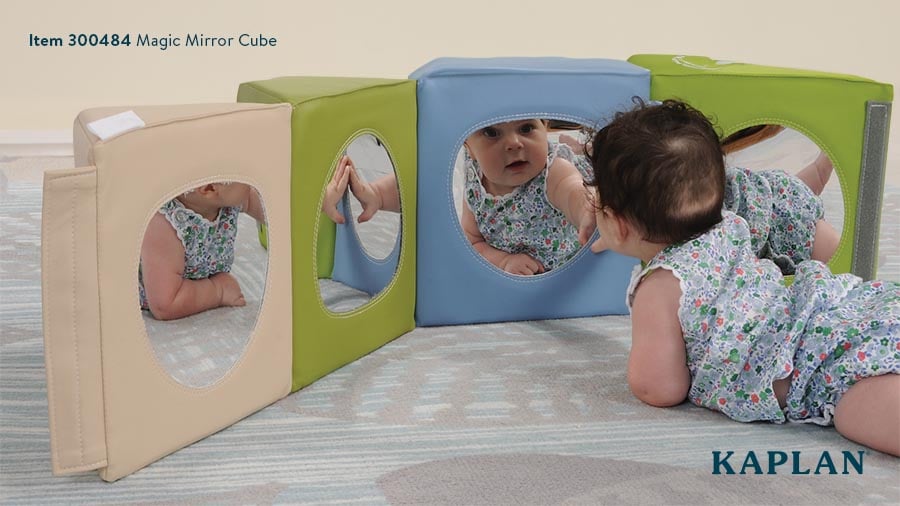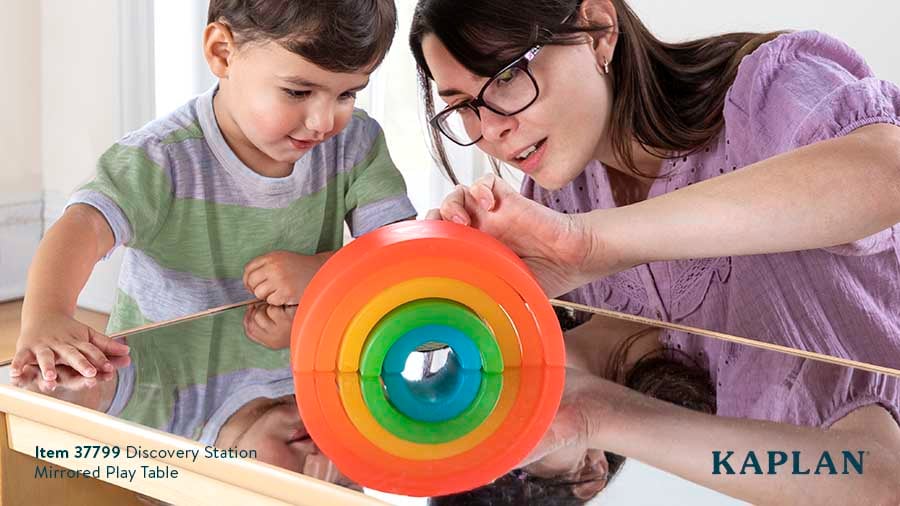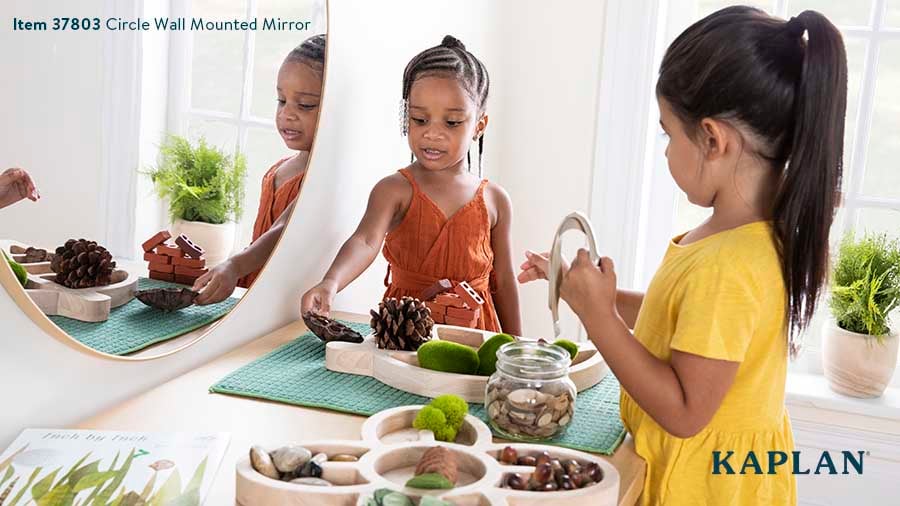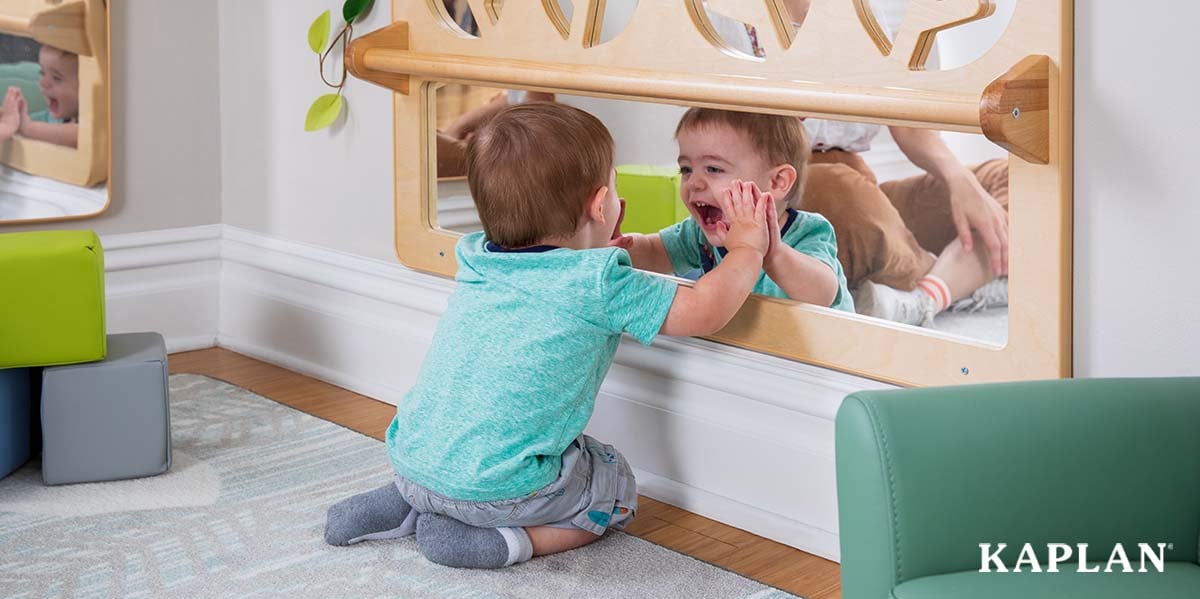For young children, mirrors create opportunities to explore body movements, establish early language skills, and begin to recognize and identify emotions. Not only that, mirrors help illuminate dark areas of the classroom, which is especially helpful in spaces that lack natural light. There are so many benefits to incorporating mirrors in your early childhood classroom.
At Kaplan, we consult with industry leaders and designers to incorporate the latest research into our mirrors for infants, toddlers, and preschool classrooms. In this article, we will share how mirrors and reflective surfaces enhance child development and explore some ways you can easily use them in your early childhood classroom.
How do mirrors and reflective surfaces improve infant and toddler development?
Infants and toddlers love interacting with and learning from their reflections. The smooth, cool surface of a mirror provides many opportunities for sensory exploration and seeing the world from a new point of view.
When watching their reflection in a mirror, infants and toddlers can learn about their bodies and observe their movements. For instance, if you place a mirror in front of a young infant while they play with blocks, they can see their hands grasp, explore, and release each block. As they repeatedly replicate these movements, they are strengthening the small muscles in their hands that they will use later to feed and dress themselves, draw, and write.
Infants and toddlers also use mirrors to watch the movement of their mouths while babbling and cooing. They also mimic the mouth movements of parents, teachers, and caregivers as they experiment with early speech and language development.
Mirrors provide opportunities for infants and toddlers to see how their inner emotions show up to the world. While looking in a mirror, they may see themselves crying and feel the wetness of tears on their cheek, or they may see themselves laughing and hear the sound of their giggles. These moments help infants and toddlers learn about their identity, begin to self-regulate, and show early signs of empathy.

How do mirrors and reflective surfaces enhance development in children ages 3 to 5?
Even older children are not always aware of how their facial expressions and mannerisms project to the world. Mirrors provide a visual aid that helps children follow social norms and take care of themselves. For example, if they notice a piece of food on their face in a mirror after lunch, they can clean up before joining the rest of their classmates for circle time.
At this age, children are learning to see things from another person’s point of view. They assume that everyone thinks, acts, and feels exactly like they do. By viewing their facial expressions in the mirror while showing an emotion, children begin to identify their feelings and how those look to others. This simple action helps children begin to understand their feelings and build self-awareness, empathy, and self-confidence.
In the preschool classroom, mirrors add depth and dimension while children play. They can stack blocks on a reflective surface to learn about symmetry, shadows, and cause and effect. Mirrors on the playground provide creative ways for children to explore insects, plants, buildings, and other views of nature from a new angle.

What other impact do mirrors and reflective surfaces have in the classroom?
Some early childhood centers were once houses, brick-and-mortar stores, or served some other purpose. The classrooms in these converted centers do not always have access to natural light sources or windows that are low enough for children to see outside. By placing mirrors strategically around the classroom, you can bounce natural light around the space and create new ways for children to view the outdoors.
Why is natural light so important? This type of illumination in a classroom improves mood, helps children focus, and enhances the ability to learn and retain information. If your classroom does not have windows that filter in natural light, use lamps and mirrors, in addition to or instead of fluorescents, to add light to your space.
How can you incorporate mirrors and reflective surfaces in your early childhood classroom?
You can incorporate mirrors and reflective surfaces in your infant, toddler, or preschool classroom in fun ways, such as:- Create a “nose cleaning station” in your classroom with a mirror, tissue box, and step-by-step instructions to help children blow their noses. They can use the mirror afterward to see how well they did.
- Position a ballet bar near mirrors in your infant classroom so children can watch their reflection as they pull up to stand and use their legs for bouncing and walking.
- Add mirrors to the wall behind your light table to create an infinity reflection and give children new ways to think about the materials they are working with at the table.
- Incorporate hand-held mirrors in your block center so children can practice building towers that “reach the ceiling” before they topple over.
- Create a cozy corner in your classroom and use mirrors to invite children into the space and away from the main activity of your classroom for quiet reflection, relaxation, and reading time.
- Take mirrors outside so infants can view tree canopies while enjoying tummy time.
- Attach mirrors to the wall at workstations so children can observe their hands as they draw, write, color, work with clay, etc.
Some of these suggestions may not work in your classroom. That is not a problem. When incorporating mirrors in your classroom, think about the children in your care and their line of sight throughout the day. Place mirrors at these different levels to allow children to interact with reflections throughout the day.
For preschoolers, you can place mirrors over sinks and drinking fountains so they can practice self-care, on tables to reflect manipulatives, and near the floor in construction centers to enhance block play. For infants, place mirrors near the floor for tummy time activities and when they are sitting up. Position mirrors and ballet bars a little higher for toddlers who are standing, cruising, and walking. You can also hang reflective objects at adult height for babies to notice during diapering routines and while you hold and carry them.

How can you ensure child safety when using mirrors in the classroom?
Safety is always a top priority in the early childhood classroom. Whether you are selecting mirrors for an infant, toddler, or preschool classroom, you want to choose those made with unbreakable and scratch-resistant reflective surfaces. This material can handle bashes from toys without shattering, cracking, or causing injury. If you notice cracks or chips in any of your classroom mirrors, remove them immediately.
Something else to consider is the size of your classroom mirrors. You want to ensure there are no small parts that could break off and cause choking and that they fit your intended classroom use.
Which mirrors are best for your classroom?
As you can see, mirrors serve an important purpose in infant and toddler classrooms. They allow children to explore, cultivate self-awareness, and develop positive social/emotional skills. After reading this article, you now have fresh inspiration for how you can incorporate mirrors into your early childhood classroom.
With so many varying sizes, shapes, and styles of mirrors, it may be difficult to determine which is best for your classroom. To help narrow your options, read this article, highlighting a few Kaplan-exclusive infant, toddler, and preschool mirrors and their best uses in the classroom. 

